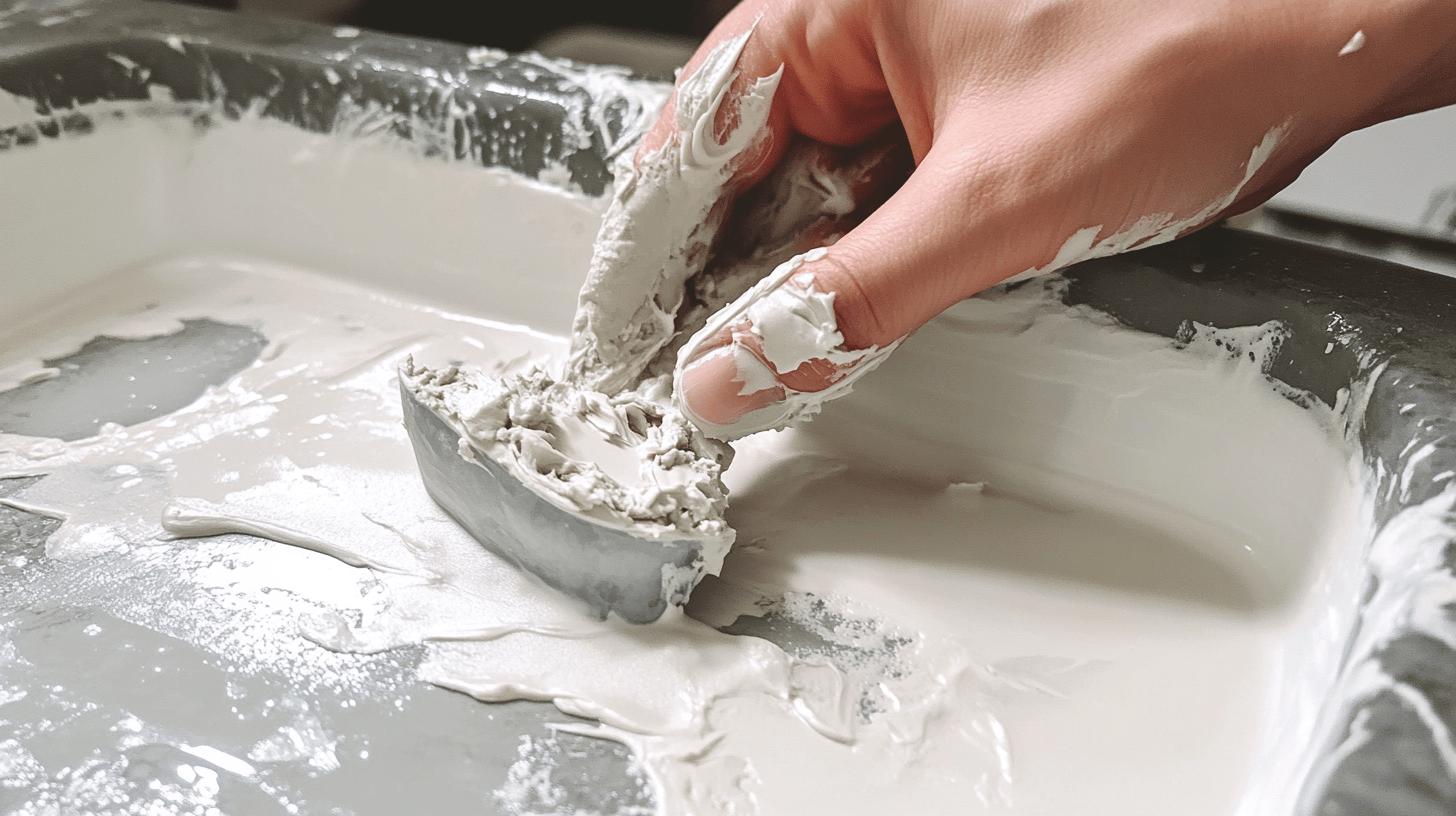TL;DR:
- Plumbers putty is a flexible, watertight sealant made from linseed oil, clay-like substances, limestone dust, and optional fillers.
- It’s easy to apply, mold, and remove, making it suitable for plumbing tasks.
Cleaning Methods:
- Use hands or a knife/chisel for removal.
- Marble/Granite: Heat gun.
- Stainless Steel/Porcelain: Soapy water, mineral spirits.
Eco-friendly Solutions:
- Vinegar, baking soda, lemon juice, Castile soap, cornstarch are effective and safe.
Common Issues:
- Use mineral spirits to remove tough residue; ensure surfaces are clean before reapplication.
Professional Help:
- Call a plumber for persistent residue, delicate materials, or complex tasks.
Ever had a tough time getting plumber’s putty off your bathroom surfaces? You’re not alone! This sticky stuff can be tricky to remove. In “Clean Plumber’s Putty: Easy Removal Tips,” you’ll find simple ways to tackle it. Whether you’re protecting your marble countertops or keeping stainless steel smooth, these tips will help you handle plumber’s putty like a pro. Ready to make cleaning easier? Let’s dive in and get it done!
Understanding Plumbers Putty and Its Composition
Plumber’s putty is a soft, flexible material that makes watertight seals in plumbing. It’s perfect for sealing drain parts like flanges, strainers, and tub drains. People like it because it’s easy to use and creates reliable seals, helping prevent leaks and keeping fixtures like sinks and faucets in place.
Composition of Plumbers Putty:
- Linseed oil
- Clay-like substances (e.g., talc, gypsum)
- Limestone dust
- Optional fillers for extra durability
Plumber’s putty is super handy because it’s soft and flexible, making it easy to use for many plumbing jobs. It molds well to different surfaces, creating an airtight seal. Plus, you can remove and reapply it as needed, which is great for both quick fixes and longer-lasting repairs. This makes plumber’s putty a must-have in any plumbing toolkit.
Methods to Clean Plumbers Putty from Various Surfaces
To remove plumber’s putty effectively, start by peeling off as much as you can with your hands. For any leftover bits, use a knife or chisel carefully to scrape it away. Soapy water can help loosen excess putty, and if you’re dealing with really stubborn residue, try using a bit of mineral spirits or paint thinner to break it down.
Cleaning Marble and Granite
When working with marble or granite, a heat gun can help. Set it to a moderate temperature—too much heat might damage these surfaces. Gently warm the putty to soften it, then wipe it off with a clean cloth. Keep the heat moving to protect the stone’s natural finish.
Cleaning Stainless Steel and Porcelain
To avoid scratches on stainless steel and porcelain, start with a soapy water solution to gently loosen the putty. If needed, use mineral spirits on a soft cloth, but make sure any cleaner you use is safe for the surface to prevent damage.
| Surface | Cleaning Agent |
|——————|———————–|
| Marble and Granite | Heat Gun |
| Stainless Steel and Porcelain | Soapy Water, Mineral Spirits |
These methods ensure your fixtures stay in excellent condition.
Safe and Eco-friendly Cleaning Solutions
When cleaning plumber’s putty, think about the impact on the environment. Harsh chemicals can damage surfaces and may be harmful to health. Eco-friendly options work well to remove putty and are safer for both you and the environment. These natural cleaners are gentle yet effective, helping you keep plumbing fixtures in great shape.
Eco-friendly Cleaning Agents:
- Vinegar
- Baking soda
- Lemon juice
- Castile soap
- Cornstarch
Natural solutions are safe and work well for removing plumber’s putty. Vinegar’s acidity helps break down residue without harming surfaces. Mixing baking soda and lemon juice into a paste can handle tougher stains. Using these options protects your fixtures and keeps your home healthier.
Troubleshooting Common Issues with Plumbers Putty
Using plumber’s putty can come with issues, like residue buildup or mistakes in applying it. If the putty has dried and hardened, take your time removing it since it can be brittle and break easily. Be sure to thoroughly clean surfaces before reapplying putty—this helps create a strong seal and prevents leaks.
Quick Solutions and Tips:
- Use mineral spirits for tough residue.
- Clean surfaces thoroughly before applying new putty.
- Dispose of old putty properly to keep a clean workspace.
Professional Plumbers vs DIY: When to Call in Experts

Hiring a professional plumber for handling plumber’s putty is smart because they have the expertise and tools to get the job done right. Their experience helps them spot and fix issues that DIYers might overlook, and they can handle complex tasks without risking damage. Pros are especially helpful when working with delicate surfaces or complicated plumbing setups, ensuring everything is sealed and secure with precision.
When Professional Help is Beneficial:
- Persistent residue resistant to DIY methods
- Cleaning or applying putty on marble or granite
- Large-scale plumbing tasks needing expertise
- Ensuring proper seals to prevent leaks
DIY methods can save money, but they come with risks. Using the wrong techniques or tools can damage surfaces or create poor seals, which may lead to leaks and eventually require a professional fix. DIY is great for simple tasks, but it’s important to assess the complexity of the job before deciding whether to tackle it yourself or call in a pro.
Final Words
Understanding plumbers putty begins with knowing its composition and how it’s used to create strong, watertight seals. With tips on cleaning different surfaces, you can manage excess putty with ease, whether using simple soapy water or more advanced tools like heat guns. Opting for safe, eco-friendly alternatives reduces chemical exposure while keeping your surfaces intact, benefiting both your home and the environment. When dealing with stubborn residue, patience and the right cleaning agents are key.
While DIY fixes offer flexibility, there are times when calling in a professional ensures a precise job and prevents damage. This guide is packed with practical advice to help you clean plumbers putty effectively, so you can tackle your next plumbing project with confidence.
FAQ
How to remove plumbers putty from pipe threads?
To remove plumbers putty from pipe threads, scrape off excess with a putty knife or chisel first. Clean any residue using a cloth soaked in mineral spirits or soapy water for a thorough finish.
How to remove old plumbers putty from a sink?
Remove old plumbers putty from a sink by scraping gently with a putty knife. Clean leftover residue with mineral spirits or warm, soapy water to make the surface smooth and ready for new application.
How to remove plumbers putty from stainless steel sink?
Use a plastic scraper or putty knife to gently remove plumbers putty from a stainless steel sink. Clean any residue using a cloth with soapy water or mineral spirits, ensuring no scratches are left behind.
How to remove plumbers putty from clothes?
Remove plumbers putty from clothes by freezing them to harden the putty. Gently scrape off excess, then treat with dish soap or a laundry stain remover before washing as per clothing instructions.
Is plumbers putty easy to remove?
Plumbers putty is relatively easy to remove when fresh, using a scraping tool. If dried, it may require mineral spirits or another solvent to help break down the residue effectively.
How to apply plumbers putty?
Apply plumbers putty by cleaning the surface first. Roll the putty into a rope-like shape and place it around the fixture’s base. Press firmly, ensuring a watertight seal without over-tightening.
How to remove plumbers glue?
To remove plumbers glue, scrape away excess using a putty knife. Apply acetone or a commercial adhesive remover to soften and clean any remaining residue for a clean, glue-free surface.
What cleans off plumbers putty?
Plumbers putty can be cleaned off using mineral spirits, warm soapy water, or a commercial cleaning solvent. For delicate surfaces, choose gentler cleaning agents to avoid damage.
Does vinegar dissolve plumbers putty?
Vinegar doesn’t dissolve plumbers putty effectively due to its oil-based composition. Instead, use mineral spirits or paint thinner for a more efficient removal, especially on stubborn areas.
How do I bring my plumbers putty back to life?
Plumbers putty cannot be revived once dried out; it must be replaced. Store it properly in an airtight container to extend its shelf life and prevent it from drying out in the future.
How to remove plumbers mait from hands?
To remove plumbers mait from hands, wipe away excess with a paper towel and wash hands thoroughly with soap and warm water. Use a gentle hand scrub if residue remains.

